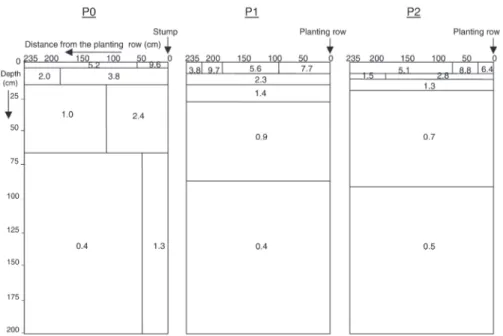HAL Id: hal-02674249
https://hal.inrae.fr/hal-02674249
Submitted on 31 May 2020
HAL is a multi-disciplinary open access archive for the deposit and dissemination of sci-entific research documents, whether they are pub-lished or not. The documents may come from teaching and research institutions in France or abroad, or from public or private research centers.
L’archive ouverte pluridisciplinaire HAL, est destinée au dépôt et à la diffusion de documents scientifiques de niveau recherche, publiés ou non, émanant des établissements d’enseignement et de recherche français ou étrangers, des laboratoires publics ou privés.
Spatial distribution of Eucalyptus roots in a deep sandy
soil in the Congo: relationships with the ability of the
stand to take up water and nutrients - Correction
Jean-Paul Laclau, Michel Arnaud, Jean-Pierre Bouillet, Jacques Ranger
To cite this version:
Jean-Paul Laclau, Michel Arnaud, Jean-Pierre Bouillet, Jacques Ranger. Spatial distribution of Eu-calyptus roots in a deep sandy soil in the Congo: relationships with the ability of the stand to take up water and nutrients - Correction. Tree Physiology, Oxford University Press (OUP): Policy B - Oxford Open Option B, 2001, 21 (9), pp.631-632. �hal-02674249�
631
TREE PHYSIOLOGY ONLINE at http://www.heronpublishing.com
In Figures 2 and 4 of the above paper, the numbering indicating root density was omitted from the published versions. The figures as they should have appeared are reproduced below.
Tree Physiology 21, 129–136
© 2001 Heron Publishing—Victoria, Canada
Spatial distribution of Eucalyptus roots in a deep sandy soil in the
Congo: relationships with the ability of the stand to take up water and
nutrients
JEAN-PAUL LACLAU,1MICHEL ARNAUD,2JEAN-PIERRE BOUILLET1and JACQUES RANGER3,4
1CIRAD-Forêt/UR2PI, BP 1291, Pointe-Noire, République du Congo 2CIRAD-Tera, BP 5035, 34032 Montpellier Cedex, France
3INRA/Nancy, Equipe Cycles biogéochimiques, 54 280 Champenoux, France 4Author to whom correspondence should be addressed
CORRECTION
Figure 2. Fine root density (FRD) automatic classification in profiles P0, P1 and P2 (FRD expressed as number of root impacts per 25 cm2 of soil area).
632
TREE PHYSIOLOGY VOLUME 21, 2001 CORRECTION
Figure 4. Density of medium-sized roots (MRD) automatic classification in profiles P0, P1 and P2 (MRD expressed as num-ber of root impacts per 25 cm2of

